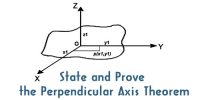The first law states that every body continues in its state of rest or of uniform motion along a straight line unless it is compelled by an external force to change that state.
This law is based on Galileo’s law of inertia. Newton’s first law of motion deals with the basic property of matter called inertia and the definition of force. Inertia is that property of a body by virtue of which the body is unable to change its state by itself in the absence of external force.
The inertia is of three types
(1) Inertia of rest
(2) Inertia of motion
(3) Inertia of direction.
(1) Inertia of rest: It is the inability of the body to change its state of rest by itself.
Examples
- A person standing in a bus falls backward when the bus suddenly starts moving. This is because. the person who is initially at rest continues to be at rest even after the bus has started moving.
- A book lying on the table will remain at rest, until it is moved by some external agencies.
- When a carpet is beaten by a stick. the dust particles fall off vertically downwards once they are released and do not move along the carpet and fall off.
(2) Inertia of motion: Inertia of motion is the inability of the body to change its state of motion by itself.
Examples
- When a passenger gets down from a moving bus. he falls down in the direction of the motion of the bus.
- A passenger sitting in a moving car falls forward. when the car stops suddenly.
- An athlete running in a race will continue to run even after reaching the finishing point.
(3) Inertia of direction: It is the inability of the body to change its direction of motion by itself.
Examples
- When a bus moving along a straight line takes a turn to the right, the passengers are thrown towards left. This is due to inertia which makes the passengers travel along the same straight line, even though the bus has turned towards the right.











